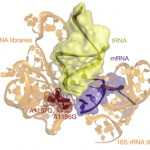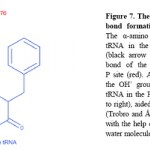ribosome
Almost every living thing shares an identical genetic code, with three nucleic acids in an RNA sequence coding for a single amino acid in the translated protein sequence. While there are 64 three-letter RNA sequences, there are only 20 amino acids and degeneracy in the code allows some amino acids to be coded by multiple codons. Chemists and synthetic biologists in the past few years have been working to expand this genetic code, with unnatural nucleotides that can be incorporated into DNA and RNA sequences and unnatural amino acids that can expand the chemical functionality of proteins.…
Welcome visitors coming from a recommendation by Dr Carmen Drahl at C&ENtral Science, the blog of the American Chemical Society's Chemical & Engineering News (C&EN):
Terra Sig has a fantastic post about the chemistry prize. The money quote: "If I see electrons being pushed around, it's chemistry."
Thank you for the kind words, Dr Drahl. New readers, feel free to weigh in down in the comments as to your take on this year's Chemistry prize.
The 2009 Nobel Prize in Chemistry has been awarded to three amazing scientists who elucidated the chemical bond-by-chemical bond action of the…
If you look below the fold, you can see two molecules locked in a tight embrace. These molecules or their closely related cousins can be found in any cell because their ability to evolve is slowed by their need to interact with each other in the right way.
In an earlier post, I asked:
Who are they?
One partner is a small bit of 16S ribosomal RNA, about 56 nucleotides to be precise. The other partner is S15, one the proteins in the ribosome.
If we could look inside the bacteria that made these, we would see lots of other proteins binding to these two partners within a molecular machine.…

